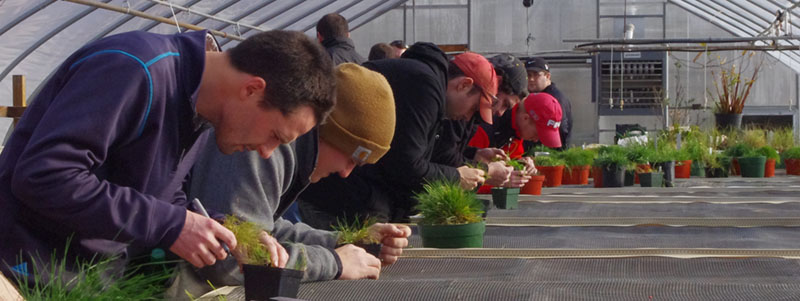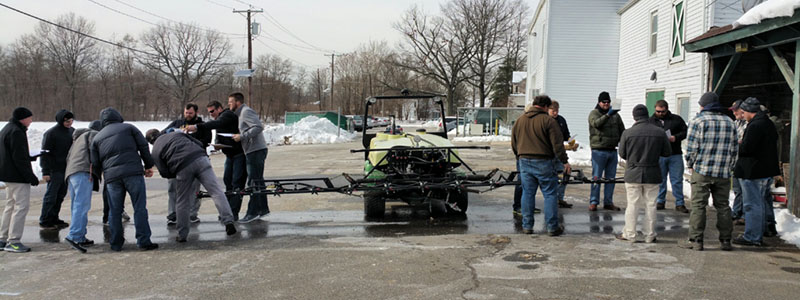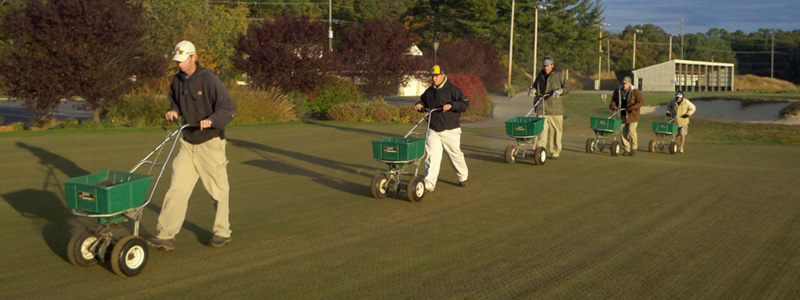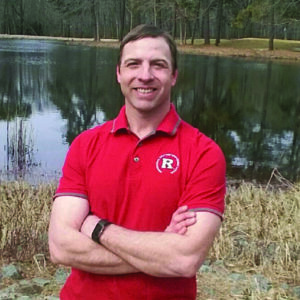Main Content
Explore the topics covered in our Two-Year Turf Certificate program, which also includes hands-on learning, field trips, and a turf internship for real-world application of classroom learning.

At the Rutgers Professional Golf Turf Management Program, our goal is to provide an innovative learning environment which promotes creative opportunities for students to attain knowledge, develop skills, build self-confidence, and ultimately become leaders in the golf turf industry.
The intensive 10-week sessions require less time away from home, family, and your workplace, while the program content is designed to help you effectively manage the challenges faced on your golf course.
Curriculum Topics for the Two-Year Turf Program
Over the two 10-week sessions you spend at Rutgers, you will receive instruction on the following topics in order to help you understand the science behind the cultural practices utilized by golf course managers, as well as refine and develop the technical skills that are applicable to the art of greenskeeping and the management of golf turf. You will also learn how to develop and justify budgets that will best serve the needs of both your golf course customers and your facilities, improve critical skills in personnel management and communication, and learn about ongoing golf turf research activities at Rutgers.
Agronomy
Learn about identification, characterization, and selection of grasses, grass breeding, seed production, and certification.
Budgeting
Learn about current strategies for projecting, monitoring, and controlling costs to achieve fiscal course goals.
Building Your Supervisor and Career Marketing Skills
Learning Goals:
This course includes a self-assessment of your learning and leadership styles, as well as an introduction to leadership dynamics and motivational strategies.
Learning Objectives:
- Learn the supervisory skills required to effectively manage a workforce.
- Better understand forces on the golf course which may impact your work as a supervisor.
- Learn concepts and practices of respected leaders.
- Review different resume styles and use them as part of a career marketing strategy.
- Produce a resume and cover letter that are immediately relevant to your industry.
- Discuss career and hiring issues with golf course superintendents.
Case Studies in Turfgrass Management
Students work in teams to apply the knowledge they have gained to solve real case problems in turfgrass management.
Diseases and Insect Pests of Ornamental Plants
Learning Goals:
This course will familiarize students with insect pest, mites, and disease problems commonly found on landscape plants in a golf course setting. Students will be expected to develop a basic understanding of the types of problems they may encounter and discuss the control of these problems in a plant health care context.
Learning Objectives:
- Understand basic plant pathology and entomology concepts.
- Develop diagnostic skills to roughly identify causes of plant health problems.
- Develop the skills to implement plant health care strategies necessary to maintain the aesthetics of the golf course environment.
Effective Communication
Learning Goals:
In this course, students will be given instruction and practice in public speaking. By making presentations to your classmates, you will learn to enhance your presentation skills. Students will then meet to discuss problems, concerns, and issues faced on golf courses across the United States and globally in this highly applied unit.
Learning Objectives:
- Learn the value of effective speaking and other communications skills related to the turf industry for personal and professional advancement.
- Develop interviewing skills, including how to deal with anxiety, questions to ask, and questions to be prepared to answer.
- Learn best practices for improving communications in professional conversations and employer/employee interactions.
- Prepare, organize, and deliver a 3-minute oral presentation.
Golf Course Construction I & II
Golf Course Construction I
Learning Goals:
Golf Course Construction I provides an introduction to golf course design principles and construction, including contours, slopes, tees, and sand bunker construction.
Learning Objectives:
- Learn the main objectives and methods of golf course construction.
- Learn which type of maps are useful and their cost to acquire.
- Learn about contours.
- Learn how to use an engineer’s scale, what slope is, how to mathematically figure it out, and how it affects a wide range of important issues in construction.
- Learn the principals of water flow and drainage, installation methods, and how to really solve a drainage problem inexpensively.
- Learn how big tees should be, different methods of how to build a tee, and how to estimate quantities of material.
- Learn the bunker style of the old architects.
- Learn different methods of how to build a new sand bunker or rebuild an old one, types of liners, and the associated costs.
Golf Course Construction II
Learning Goals:
Golf Course Construction II focuses on construction costs, developing contracts, and scheduling construction projects, including ponds, cart paths, and greens.
Learning Objectives:
- Learn how ponds are built and the different types of pumps and pumphouse.
- Learn how to figure out how much material has to be excavated when building a pond.
- Learn about retaining walls construction, including types of walls (railroad ties, pre-cast concrete, and gabions walls)
- Learn the proper way to build steps and how to put in cart paths.
- Learn about the history of the putting green, including ‘push-up’ greens, USGA putting green specifications, and California greens.
- Learn about the proper slopes on a green and pin placement.
- Learn steps in the planning process, how to research the history of a golf course, and how to work with a golf course architect.
- Learn how to implement a master plan.
- Learn about different methods to bid a project and different types of construction contracts.
- Learn about ball-park construction costs, both for private projects and government projects.
Golf Course Design History and Principles
Learning Goals:
Students will be introduced to the history of golf course design and some of its basic principles.
Learning Objectives:
- Learn where golf started in the world and in the USA and about the great golf architects of the past.
- Learn the four types of golf courses and the four design styles of golf holes.
- Learn about famous named golf holes such as a “Redan Hole.”
- Learn about the main organizations in the golf industry.
- Learn what a golf course superintendent can do to make their golf course look better from a design perspective.
Irrigation Principles I & II
Irrigation Principles I
Irrigation Principles I includes lectures and hands-on exercises teaching options and proper procedures for repair of pipes, wires, valves, sprinkler heads, and controllers. Students learn how to troubleshoot and diagnose wiring problems and control systems and develop maintenance and repair skills.
Irrigation Principles II
Irrigation Principles II focuses on water supply, hydraulic principles, piping, fertigation, sprinkler layout, irrigation system efficiency, and pump house installation practices. Students learn about evaluating irrigation systems, irrigation contracts, preparing plans and bid documents, and performing contract management.
Landscape Design and Ornamental Grasses
The primary focus of this class is on planting design and how distinct plant groups function as design elements. Naturalistic and interpretive styles will be explored and noteworthy examples from famous golf courses nationwide will be used to illustrate the various points covered. Overall, the course is constructed to make the participants aware of the benefits and advantages of high-quality design so that they will promote its use. In addition, they will get a better understanding of how to analyze the unique design problems on their own golf courses and how to begin to implement the design process in solving them.
It will also include an introduction to the classification, cultivation, and maintenance of ornamental grasses, plus control of invasive species.
Landscape Management and Plant Physiology
Learning Goals:
Learn about the management and maintenance of landscape plants, proper planting procedures, and pruning techniques, along with an introduction to the structure, function, physiology, growth, and development of higher plants.
Learning Objectives:
Through the introductory study of Ecology, the students will gain an understanding of the scientific basis for all of landscape management and an insight into the processes which make maintenance tasks necessary. The course also will also focus on specific maintenance topics with an eye on design intent and will discuss the use of plants as management tools, as well as how to preserve them in a landscape under construction. Pruning will be discussed in-depth and will include a field exercise. Overall, the participants should more fully grasp the place of landscape management and maintenance in the overall scheme of the creation and care of the built environment.
Landscape Plants I & II
Landscape Plants I
Landscape Plants I covers identification and landscape uses of shade and small trees, deciduous shrubs, and ground covers.
Landscape Plants II
Learning Goals:
Landscape Plants II will be devoted to the study of evergreens (both coniferous and broadleaf), including trees and shrubs. There will also be a brief discussion of woody landscape plants found in both tropical and desert regions.
Learning Objectives:
- Enable students to properly identify various evergreen trees and shrubs.
- Develop a useful list of evergreen trees and shrubs that a student will be able to employ at the golf course for various landscape uses.
- Realize and appreciate the ornamental assets and functional use of such evergreens as they apply to the golf course.
- Understand the cultural requirements (exposure, soil types, etc.) and liability (if any) associated with such evergreens.
Mathematics for Golf Course Superintendents I & II
Students who successfully complete these courses will gain an understanding of mathematical principles used for turfgrass management. The concepts presented will help prepare students for the real-world experiences that will be observed in their turfgrass management careers.
Mathematics for Turfgrass Management I
Learning Goals:
The goals of this section are to introduce the multiple applications of mathematics on and around the golf course, including mixing, measuring, and calibrating.
Learning Objectives:
Students will learn calculations for area, volume, fertilizers, pesticides, and seedings.
Mathematics for Turfgrass Management II
Learning Objectives:
Students will learn to perform irrigation calculations and to calibrate spreaders and sprayers.
Mower Technology
This course takes a look at the critical aspects of mower selection, set up, and maintenance. After completing this course, students will understand how cutting units operate to better develop a maintenance routine that will get the most out of their equipment.
Principles and Applications of Plant Health Products
Learning Goals:
This section will provide a foundational understanding of plant health products and how they can be effectively used in turfgrass management. Several different types of plant health products will be discussed, including plant growth regulators, pigmented fungicides, and biostimulants. Examples of case studies and research trials highlighting the effects of plant health products on improving turfgrass growth and stress tolerance will also be included.
Learning Objectives:
- Learn how to understand and define plant health.
- Gain a comprehension of how different plant health products function.
- Develop confidence in deciding when and how to properly apply plant health products.
Principles of Pest Management
Learning Goals:
The goal of this course is to familiarize the student with current pest management practices used on golf courses. Strategies to control insect pests and disease agents will be explored with a strong focus on the concept of Integrated Pest Management. The course material will be closely aligned with the information presented in the other disease and insect courses.
Learning Objectives:
- Understand basic Integrated Pest Management concepts.
- Understand fungicide selection and use.
- Understand insecticide selection and use.
- Understand alternatives to traditional pesticides for disease and insect pest management.
- Develop the skills to implement disease and insect management programs.
Professional Development – Greens Committee Presentations
Learn the critical lessons to achieve credibility among your peers and golf customers alike.
Regional Concerns
Students will discuss problems, concerns, and issues faced on golf courses across the United States and globally in this highly applied unit. Each student will prepare, organize, and deliver a 3-minute oral presentation.
Soils I & II
Soils I
Learning Goals:
This course is an introductory level course in soil science. The student will develop and acquire an intellectual curiosity leading toward a basic understanding of the physical properties of soils and their relationship to the growth of plants. Students will also develop an appreciation for the unique soil conditions demanded of and created by golf course turf management.
Learning Objectives:
Gain an understanding of:
- The soil as a physical entity i.e. its formation, physical properties and structure
- Soil water
- Soil organic matter and soil organisms
- How turf management practices affect soil
- Hydrophobic soil and wetting agents
- The land grant college/cooperative extension
Soils II – Soil Chemistry and Soil Fertility
Learning Goals:
Students will develop an understanding of critically important soil fertility and management concepts related to cation exchange capacity, base saturation, soil pH, salt-affected soils, soil testing concepts, soil biology, and fertilizer management. Students will also demonstrate an understanding of the inter-relatedness of these critically important concepts by developing a fertility management plan for their current (or future) properties. This course is designed for those seeking career opportunities in the science and management of golf courses and other turfgrass landscapes, including lawns, gardens, parks, roadsides, cemeteries, athletic fields, etc.
Learning Objectives:
- Be able to understand soil chemistry concepts and management principles related to soil cation exchange capacity (CEC), soil pH, and salt-affected soils.
- Understand the major differences between crop fertility principles and practices versus turfgrass fertility principles and practices.
- Understand turfgrass nutrient management principles for N, P, K, Ca, Mg, S, and micronutrients.
- Be able to understand and interpret soil test reports.
- Be able to develop a soil chemistry and nutrient management plan for a golf course (or other turfgrass site).
Surveying
Learning Goals:
Learn surveying tools and techniques turf managers should know; includes hands-on experience using current survey equipment.
Learning Objectives:
- Learn types of surveying equipment and the basics of setting a benchmark.
- Learn how to level a dumpy level and survey to determine elevation based on benchmark.
- Review how to survey to set grade stakes for building a new tee and to install drainage.
Turfgrass Disease Laboratory
This class includes hands-on experience viewing turfgrass pathogens and diseased material from our turfgrass education center. Learn to use a microscope for diagnostics.
Turfgrass Diseases
Learning Goals:
This course will focus on the concept of plant disease and the biology of plant pathogens in the turfgrass system.
Learning Objectives:
- Understand plant pathology concepts.
- Understand the nature of the causes of turfgrass diseases, influence of the environmental and cultural conditions on disease development, and disease management strategies.
- Develop skill in diagnosis and management of turfgrass diseases.
Turfgrass Identification and Development
Learning Goals:
The student will develop a basic understanding of the lifecycle of a turfgrass plant including seed germination, shoot and root growth, flowering, and seed production. The student will gain an understanding of how the life cycle of a turfgrass plant influences turf maintenance practices such as mowing, establishment, etc.
Learning Objectives:
- Identify the different structures of the turfgrass plant.
- Identify parts of the turfgrass seed.
- Learn how turfgrass seeds germinate.
- Identify turfgrass meristems.
- Learn how turfgrass leaves form.
- Identify the different growth habits of turfgrass plants.
Turfgrass Insect Laboratory
This hands-on course covers identification of insect pests with an emphasis on management and control strategies.
Turfgrass Insects
Learning Goals:
This course will focus on the biology of insect pests in the turfgrass system. Principles of insect pest diagnosis based on symptom development, recognition of key pests in turf, environmental and cultural management factors influencing insect outbreaks, significance of insect life cycle in epidemic development, and integrated turfgrass insect management practices will be discussed including scouting techniques and insecticide selection.
Learning Objectives:
- Understand basic entomology concepts.
- Develop skill in the identification of the most common turfgrass insects.
- Understand turf insect life cycles and how they can be used in control programs.
- Develop the skill to implement turfgrass insect management strategies.
Turfgrass Maintenance I & II
Turfgrass Maintenance I
Turfgrass Maintenance I covers mowing, watering, fertilizing, cultivating, and controlling thatch on greens and fairways for optimal effect and minimal cost.
Turfgrass Maintenance II
In Turfgrass Maintenance II, students learn innovative techniques and specifications for seeding, sprigging, and sodding, along with current applications and discussion of the challenges students faced during their summer work experiences.
Turfgrass Stress Management
Learning Goals:
Expand on how turfgrass adapts to environmental stress and how to successfully control and prevent damage.
Learning Objectives:
- Understand how turfgrass plants respond to environmental stresses, including drought, heat, and cold stress.
- Learn effective practices to better manage turfgrass in areas and during periods of time with limited irrigation, heat stress, and winter injury.
Turfgrass Weeds I & II
Turfgrass Weeds I
Learning Goals:
This course examines weeds as a pest of golf course turf systems and landscapes. The course will cover weed identification and biology, and it will establish the fundamentals of weed control and management strategies. Identification and biology topics will include life cycles, morphology, reproduction, species characteristics, and identification tools and methods. Additionally, the course will explore the implications of weed infestations and effects on turfgrass, and establish the groundwork for developing an effective weed management strategy.
Learning Objectives:
- Possess the ability to identify weed species of significance affecting golf course landscapes.
- Understand the basic biology and life cycles of significant weed species.
- Understand the effects of weed infestations on turf health and aesthetics.
- Establish the fundamentals of weed control.
- Establish the fundamentals of developing an integrated weed management strategy for the golf course.
Turfgrass Weeds II
Learning Goals:
This course examines weed control strategies and presents the process of developing an integrated weed management program for the golf course. Herbicide use, application, resistance, and implications will be covered. A weed management program using cultural, chemical, and integrated strategies will be examined.
Learning Objectives:
- Understand control options for significant weed species affecting golf course landscapes.
- Possess the ability to use available resources for finding and implementing available control options for problematic weeds.
- Understand the implications and concerns of using chemical control materials on both weeds and desired turfgrass.
- Develop an effective weed management program using cultural, chemical, and integrated strategies.
Hands-on Learning for Turf Students

Hands-on training in our on-site workshop and greenhouse demonstrates concepts learned in the classroom and provides opportunities for practicing and strengthening newly-learned skills. You will have the chance to participate in soil tests, reel grinding demonstrations, plant identification walks, sprayer calibration, spreader training, irrigation pipe fitting, disease identification using microscopes, and more.
Turf Management Internship

Students are required to complete 200+ hours of field experience (paid internship) following their first ten-week session in the program. You may complete your internship by working on the golf course at which you are currently employed. If you prefer to gain experience on a new course, we can tap into the Rutgers Turf alumni network in order to assist you in locating an internship position throughout the United States or even internationally. Check out the Turf Industry Jobs and Internships board from the Rutgers Center for Turfgrass Science to see the types of opportunities available for Rutgers students.
Requirements for all internships include maintaining a daily log of activities, actual operation of various pieces of equipment, and participating in various cultural practices. You will present your field experience activities in a written and oral report during your second ten-week session.




